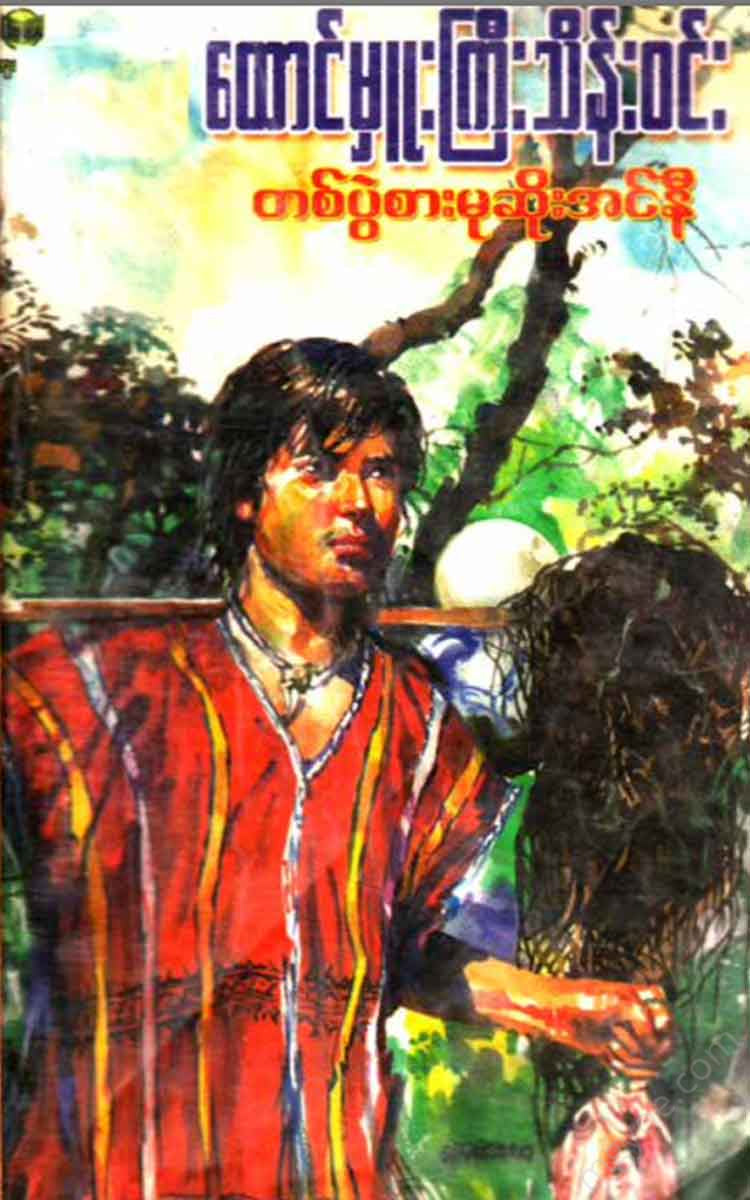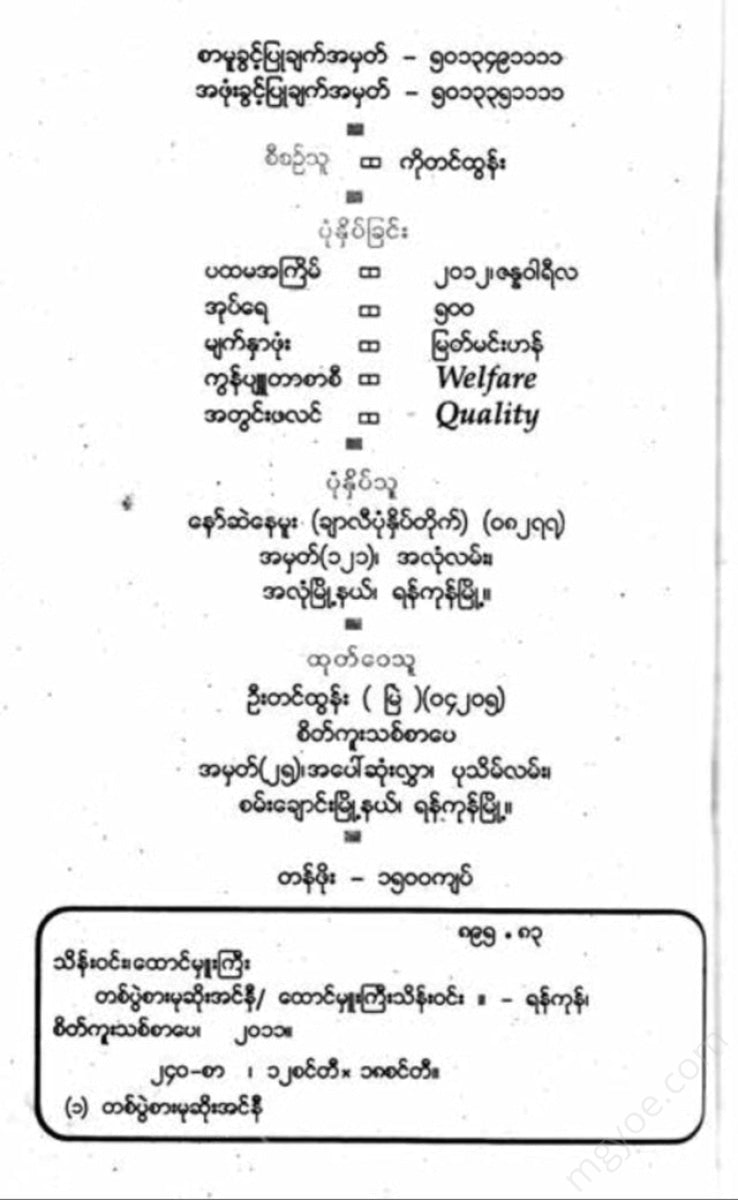Other Websites
Prisoner Thein Win - One-player Hunter Annie
Prisoner Thein Win - One-player Hunter Annie
Couldn't load pickup availability
Katha, where our Forest Department is based, is very beautiful. To the west of Katha, the green and brown mountains surround the town. Katha, located on the banks of the Ayeyarwady River, is even more beautiful when viewed from the riverbank.
Along the coastal road, you can see the beautiful golden pagodas of Katha, the Tawatisa Maha Abaya pagoda, and the Shwe Ku Kyi Pagoda with their magnificent golden courtyards. In addition, there are many boats, ships, and yachts docked at the Katha port, making it very lively and beautiful in the evening.
In ancient times, Katha was called “Kamtha”. In Shan language, it is also called “Kapsa”. “Kansa” means “Mingtha Market Town ”. It is also known that it was called “Katha Tiger Town ” in ancient times.
Katha was one of the 43 major cities founded by King Anawrahta of Bagan in 395 B.E. Moeta and Yinke, which were major cities at that time, are now just large villages near Katha.
Katha is bordered by Kachin State and Moehnyin Township to the north, Shweku Township and Ma Bhin Township of Shan State to the east, Htee Chin Township to the south, and Intaw Township to the west.
Katha Township is surrounded by the lush green Minwan Mountain Range, Phatthut Mountain Range, and Suil Mountain Range, stretching from north to south. The Ayeyarwady River and the natural forested mountains complement the natural beauty of Katha. Katha is also an ancient city nestled in the mountains of water and forests.
In short, Katha is a city with abundant water, forests, and springs, and a balanced climate. In the mountains and slopes, valuable trees such as teak, pyin katoe, in, kanyang, yin ma, yaman, and yong thit grow in abundance. In this forest, valuable and useful bamboos such as wide-eyed bamboo, white bamboo and ting bamboo, kyaung bamboo, yay bamboo, black bamboo, and ting bamboo also grow intermingled.
The eastern banks of the Ayeyarwady River in Katha Township are also connected to the Shan Yoma Mountains. In the lowland forests and flatlands, Moemakha, Yechinya, Traw Pin and Tazin trees also grow everywhere. Three-quarters of the township is covered with forests. Therefore, Katha Town has a relatively balanced climate. ,
We have our forest boat on the shore. There are also small INSPECTING BOATS, also known as U BOATS, used by the timber industry. These boats travel up and down the Ayeyarwady River to inspect timber operations.
Our forestry office buildings are on the west side of the town, on either side of the railway station. Our cottages are also inside the timber industry. When senior forest officials come, they are accommodated in the forest huts on the banks. The Katha Township Timber Industry Department has two buildings. We also use them occasionally.
Besides the coastal road, there is another forest lodge on the eastern bank of the Ayeyarwady River.
Near the hut, there are woodworking machinery and vehicles. There is also a vehicle repair shop. It is supervised by a vehicle manager. The driver's family also lives in small houses. There is an elephant camp a short distance away.
The elephant camp is located in large wooded areas when the weather is nice. This is to avoid wasting time traveling to large wooded areas that are far from the office and to provide food and water for the elephants.
In the eastern part of the country, there are large forests of the Nganai, Nma Mae, Kun Chaung, and Sint Ku forests, which produce valuable hardwoods. In the western part, the Myitteng and Inn regions are the main areas for timber production.
These are Taw Township, Mawlu Township, and Bhammauk Township. Because of the high quality hardwoods produced, Katha is known as a township with a large timber industry.
The Yin River on the east coast is world famous. Since the time of the Burmese kings, the Burmese king has been a German...
A man named “Brin Sith” was hired with a salary and rations to systematically harvest timber. Brin Sith drew a SITE PLAN, designated the large forest as a protected forest, and divided it into (30) large timber plots.
It is said that large trees grow 1 foot in circumference every 30 years. Only the standard size trees in a large plot are selected and cut down each year. At that time, the standard size of a tree trunk was defined as (7'x6"). Nowadays, the standard size is only (7) feet.
One block is cut down each year, so after 31 years, when the first block is returned, the trees that were left behind, not yet mature, are now (7'x6") in diameter and are now new. This is a very systematic way of working.
Note: Nowadays, due to the high volume of timber extraction, the system of logging is no longer as it was in the past. Companies have come in and not only left the quality trees, but also cut them down using the "clear cut" system. This world-famous forest is now a vast forest, with large sugarcane plantations.
In the west, there are large timber production areas in Myat Tham, Intaw, Maw Du, Bham Mauk, Hom Malin, Khanti, Htee Cheung, Bham Ma, Mansi, Bhanganbu, Kaw Lin, Wun Tho, and along the Uru River.
Our work involves traveling through rivers, streams, and forests and mountains regardless of the season, so my hobbies of collecting orchids, searching for medicinal plants, and hunting are related to our forestry work and have become my hobbies.
Our forest department has a Belgian-made GREENER single-shot rifle, a US-made rifle, an English-made double-barreled shotgun, and a Czech-made .375 Magnum rifle. It has a very strong recoil. It can shoot wild boar, deer, deer, moose, elk, tiger, bear, and even elephant with confidence.
I also have a SMITHAND WATSON short barrel revolver made in England for emergency close-range shooting. It is good for close-range shooting and has a loud sound that is good for scaring people. However, it is a short barrel type and is not easy to hit the target accurately unless you are trained.
My subordinate, the forest ranger Zaw Min, is a double-barreled gunsmith. If you pull his heavy-duty double-barreled gun twice, you will definitely get two birds. My student, Kyaw Sein Win, a typist, gave me my own 22-point SEMI AUTO bird-shooting gun, but he couldn't hold it.
He usually carries only a long, sharp, buffalo horn-like bird's tail and an eight-inch hunting dagger made by U Che Gyi, a famous blacksmith from Katha. This morning, our group will cross to the east bank of the Ayeyarwady River and inspect the large area (30) at the far end of this ring.
Forester Zaw Min and I went down to the shore with our weapons and went to the “Shwe Kamtha Tea Shop” at 5 am as scheduled, where our disciple Kyaw Kyaw Sein Win was waiting for us at the shop.
Besides him, we also saw a Karen man wearing a Karen shirt with no underwear, and underneath, a long-sleeved robe with a patterned pattern that looked like a robe or a cloth, rolled up like a monk's robe.
He was about 40 years old. He had a short, stubbly head of hair, but was strong. He also had a large, long sword, along with a dagger, strapped to his back.
Kyaw Sein Win, “Teachers… please sit down. As usual, we have fried rice, egg and Malay tea. This is my friend “Ko Eni”. He came to my house yesterday evening and asked me to sleep at home and we will go to the forest this morning. I invited him.
Ko Ini was born in the forest of Yinke, and can smell prey from afar. He is very good at finding prey. He also works as a hunter. If hired by a hunting group, he will guide them to the prey. He is also called “Hunter Ini of the Match”. There is no day when he does not catch a wild animal, sir.”
“Ko Ini ... The teachers here are U Nay Aung, the forest officer, and Ko Zaw Min, the forest ranger. They are teachers from my department. They are hunters who go to the forest and the mountains. They have a lot of experience and have shot all kinds of wild animals.” Ko Ini, “Yes.. It’s nice to meet you. I’m a hunter too. A hunter, a hunter.” Me.. “Ko Ini is a hunter, a hunter. I think he’s Karen. His name is Bo San.”
We shook hands. His hands were large and strong.



